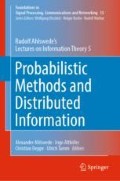Abstract
The arbitrarily varying channel (AVC) was introduced under a different name by Blackwell, Breiman, and Thomasian [1] and considerable progress has been made in the study of these channels. It is probably one of the most interesting models in information theory because of the following phenomena which are not present in simpler models.
Access this chapter
Tax calculation will be finalised at checkout
Purchases are for personal use only
References
D. Blackwell, L. Breiman, A.J. Thomasian, The capacities of certain channel classes under random coding. Ann. Math. Stat. 31, 558–567 (1960)
R. Ahlswede, Elimination of correlation in random codes for arbitrarily varying channels. Z. Wahrscheinlichkeitstheorie Verw. Gebiete 33, 159–175 (1978)
J. Kiefer, J. Wolfowitz, Channels with arbitrarily varying channel probability functions. Inf. Control 5, 44–54 (1962)
R. Ericson, Exponential error bounds for random codes in the arbitrarily varying channel. IEEE Trans. Inf. Theory 31, 42–48 (1985)
I. Csiszár, P. Narayan, The capacity of arbitrarily channels revisited, positivity, constraints. IEEE Trans. Inf. Theory 34, 181–193 (1988)
R. Ahlswede, J. Wolfowitz, The capacity of a channel with arbitrarily varying channel probability functions and binary outputalphabet. Z. Wahrscheinlichkeitstheorie Verw. Gebiete 15, 186–194 (1970)
R. Ahlswede, N. Cai, The AVC with noiseless feedback and maximal error probability, a capacity formula with a trichotomy, in Numbers, Information and Complexity, Special volume in honour of R. Ahlswede on occasion of his 60th birthday, ed. by I. Althöfer, N. Cai, G. Dueck, L.H. Khachatrian, M. Pinsker, A. Sárközy, I. Wegener, Z. Zhang (Kluwer Academic Publishers, Boston, 2000), pp. 151–176
I. Csiszár, J. Körner, On the capacity of the arbitrarily varying channel for maximum probability of error. Z. Wahrscheinlichkeitstheorie Verw. Gebiete 57, 87–101 (1981)
R. Ahlswede, A note on the existence of the weak capacity for channels with arbitrarily varying probability functions and its relation to Shannon’s zero error capacity. Ann. Math. Stat. 41, 1027–1033 (1970)
C.E. Shannon, The zero error capacity of a noisy channel. IRE Trans. Inf. Theory IT–2, 8–19 (1956)
R. Ahlswede, Channels with arbitrarily varying channel probability functions in the presence of noiseless feedback. Z. Wahrscheinlichkeitstheorie Verw. Gebiete 25, 239–252 (1973)
R. Ahlswede, N. Cai, Two proofs of Pinsker’s conjecture concerning arbitrarily varying channels. IEEE Trans. Inf. Theory 37, 1647–1649 (1991)
V.M. Blinovsky, O. Narayan, M.S. Pinsker, Capacity of the arbitrarily varying channel under list decoding. Probl. Inf. Transm. 31, 99–113 (1995), translated from Problemy Peredačii Informacii 31(2), 3–19 (1995)
B.L. Hughes, The smallest list for arbitrarily varying channel. IEEE Trans. Inf. Theory 43(3), 803–815 (1997)
R. Ahlswede, Channel capacities for list codes. J. Appl. Probab. 10, 824–836 (1973)
R. Ahlswede, The maximal error capacity of arbitrarily varying channels for constant list size. IEEE Trans. Inf. Theory 39, 1416–1417 (1993)
P. Elias, Zero error capacity under list decoding. IEEE Trans. Inf. Theory 34, 1070–1074 (1988)
R. Ahlswede, Arbitrarily varying channels with states sequence known to the sender. IEEE Trans. Inf. Theory 32, 621–629 (1986)
R. Ahlswede, N. Cai, Correlated sources help the transmission over AVC. IEEE Trans. Inf. Theory 43(4), 1254–1255 (1997)
R. Ahlswede, The capacity of a channel with arbitrarily varying additive Gaussian channel probability functions, in Transactions of the Sixth Prague Conference on Information Theory, Statistical Decision Functions, Random Processes (1971), pp. 13–21
I. Csiszár, P. Narayan, Capacity of the Gaussian arbitrarily varying channel. IEEE Trans. Inf. Theory 37, 18–26 (1991)
J.-H. Jahn, Coding of arbitrarily varying multiuser channels. IEEE Trans. Inf. Theory 27, 212–226 (1981)
J.A. Gubner, On the deterministic–code capacity of the multiple–access arbitrarily varying channel. IEEE Trans. Inf. Theory 36, 262–275 (1990)
R. Ahlswede, N. Cai, Arbitrarily varying multiple–access channels, part I, Ericson’s symmetrizability is adequate, Gubner’s conjecture is true. IEEE Trans. Inf. Theory 45(2), 742–749 (1999)
R. Ahlswede, N. Cai, Arbitrarily varying multiple–access channels, part II, correlated sender’s side information, correlated messages and ambiguous transmission. IEEE Trans. Inf. Theory 45(2), 749–756 (1999)
I. Csiszár, Arbitrarily varying channels with general alphabets and states. IEEE Trans. Inf. Theory 38, 1725–1742 (1992)
R. Ahlswede, Coloring hypergraphs, a new approach to multi–user source coding. J. Comb. Inf. Syst. Sci. I 4, 76–115 (1979) and II 5, 220–268 (1980)
I. Csiszár, P. Narayan, Capacity and decoding rules for arbitrarily varying channels. IEEE Trans. Inf. Theory 35, 752–769 (1989)
T.M. Cover, A. ElGamal, M. Salehi, Multiple–access channel with arbitrarily correlated sources. IEEE Trans. Inf. Theory IT–26, 648–659 (1980)
M. Hizlan, B.L. Hughes, On the optimal of direct sequence for arbitrary interference rejection. IEEE Trans. Commun. 39, 1193–1196 (1991)
D. Blackwell, L. Breiman, A.J. Thomasian, The capacity of a class of channels. Ann. Math. Stat. 30, 1229–1241 (1959)
I. Csiszár, P. Narayan, Arbitrary varying channels with constrained input and states. IEEE Trans. Inf. Theory 34, 27–44 (1988)
Author information
Authors and Affiliations
Corresponding author
Editor information
Editors and Affiliations
Rights and permissions
Copyright information
© 2019 Springer Nature Switzerland AG
About this chapter
Cite this chapter
Ahlswede, R. (2019). Preliminaries. In: Ahlswede, A., Althöfer, I., Deppe, C., Tamm, U. (eds) Probabilistic Methods and Distributed Information. Foundations in Signal Processing, Communications and Networking, vol 15. Springer, Cham. https://doi.org/10.1007/978-3-030-00312-8_1
Download citation
DOI: https://doi.org/10.1007/978-3-030-00312-8_1
Published:
Publisher Name: Springer, Cham
Print ISBN: 978-3-030-00310-4
Online ISBN: 978-3-030-00312-8
eBook Packages: EngineeringEngineering (R0)

